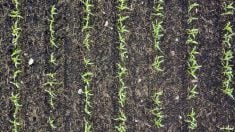The 2023 growing season was drier and warmer than normal resulting in lower-than-normal crop yields over much of the Prairies. The worst affected areas are in the Brown and Dark Brown soil zones. Figure 1 shows an Agriculture and Agri-Food Canada map of soil moisture conditions across the Prairies at the end of July 2023. Much of the southern region of the Prairies had modest rainfall on Aug. 21 and 22.
The effects of dry soil conditions can persist into next year. Things such as soil nutrient levels, insect populations and herbicide residue carry-over can be affected. In this article, I will briefly address a significant negative concern of the drought — the increased risk of herbicide residue carry-over. This can be a serious concern when moisture conditions are dry throughout the growing season.
Read Also

Gentle treatments for pain in the neck
Heading toward year-end, people unknowingly tense up against the cold and busyness, causing neck pain that can often be treated with appropriate support and gentle mobility, athletic therapist Kathlyn Hossack says.
Herbicide breakdown and degradation is affected by several factors including:
- The type of herbicide and its characteristics
- Soil moisture and temperature conditions
- Soil type, including amount of clay, soil pH and soil organic matter level
Herbicide molecules break down either by various chemical or microbial processes, or both. Because of the many chemical and biological processes that occur in soil, it can be difficult to predict how quickly a herbicide will break down and the risk of residue carry-over.
After application, most herbicides tend to break down reasonably quickly with good soil moisture and temperature conditions during the 60- to 80-day period after application. However, when dry soil conditions persist for several months after herbicide application, herbicide degradation can be greatly reduced, which increases the risk of herbicide residue carry-over. When soils are dry, negatively charged herbicide molecules can attach to clay particles or soil organic matter, which further reduces the potential breakdown processes.
For some herbicides, when soil organic matter level is less than four per cent, the potential carry-over risk is increased. Lower or higher soil pH may increase carry-over risk for some herbicides. Soils in the Brown and Dark Brown zones usually are less than four per cent in organic matter and tend to have a higher pH, putting these soil types at higher risk of herbicide residue carry-over.
When soil moisture conditions are drier than normal in the 60- to 80-day period after application, the breakdown processes can be greatly reduced. Even if soils become moist in late summer or fall, cooler soil temperatures can slow the breakdown processes.

If precipitation was less than 75 to 100 millimetres (three to four inches) on your farm for two months after herbicide application, the risk of herbicide carry-over can be high to very high depending on soil type factors and herbicides used. If precipitation was low during the growing season on your farm, it would be wise to review all herbicides used on your land this season, and do a risk assessment of potential carry-over concerns for herbicides used. For herbicides of concern, consult with your crop adviser, ag input provider, chemical rep, and/or provincial government extension specialist (in Saskatchewan and Manitoba — Alberta no longer has extension specialists) for their expert opinions. It is always wise to seek at least several expert opinions.
For herbicides on your list of concern for carry-over, work with your crop or input adviser and consider sending representative soil samples to a lab for analysis to determine the presence of herbicide residue and the concentration levels. This can be costly but can be worth the expense.
Another option is to work with your crop adviser to do your own bioassay using soils taken from fields of concern on your farm. This involves taking samples from the top three to four inches of topsoil, from representative areas of a uniform field of concern.
Ensure the samples are well mixed and laid out in trays or pots. Then seed the crop you plan to grow next year in one tray and a tolerant crop in a second tray. Make sure to sample a suitable control soil from an unaffected field and plant to the same two crops in the control soil trays for comparison. Planting a tolerant crop into the soil of concern and a control soil provides for additional comparison. Be sure to carefully label each tray with the soil type and crop.
If a field of concern has variable topography or soils with variable texture, organic matter and/or pH, be sure to take separate, representative samples from each unique soil area. Place each soil type in separate trays and seed each separately to the planned crop next year and a tolerant crop for comparison. Make sure to use a suitable control soil from an unaffected field and plant to the same two crops in the control soil trays for comparison. Again, be sure each tray is carefully labelled with the soil type, field location, crop and date seeded.
After planting, wet the soil in each tray but not to saturation, just keep soils moist enough for good germination and emergence. Keep the soils moist for reasonable plant growth but not overly wet, to allow greater potential expression of herbicide injury. Don’t let the soils dry out as this could cause plant wilting, which would be unrelated to herbicide injury. Keep the trays in a warm, reasonably sunny location with modest watering.
Continually observe the plant growth in each of the soil trays of concern versus the control soils. Injury symptoms should appear about three weeks after planting but let the plants grow for at least five weeks to ensure full exposure to herbicide persistence. Take frequent notes and take side by side pictures of plants in control soil trays versus soil trays of concern.
If any herbicide injury symptoms are observed, discuss with your crop or input adviser for guidance to decide on crop planting strategies for next year. Extension staff with Saskatchewan Ag or Manitoba Ag are excellent sources for information and guidance. If injury symptoms are observed in soils of concern, seeding a tolerant crop into the field of concern next year is usually the best approach.
I always encourage farmers to seek advice, options and guidance from several different agronomists to wisely develop cropping plans. Some herbicide carry-over situations can be complex. Contacting a research scientist or agronomist in your region with strong expertise in herbicides to assist you with understanding the causes of the herbicide persistence and how to plan your crop management for the next year can be very helpful. GN
















